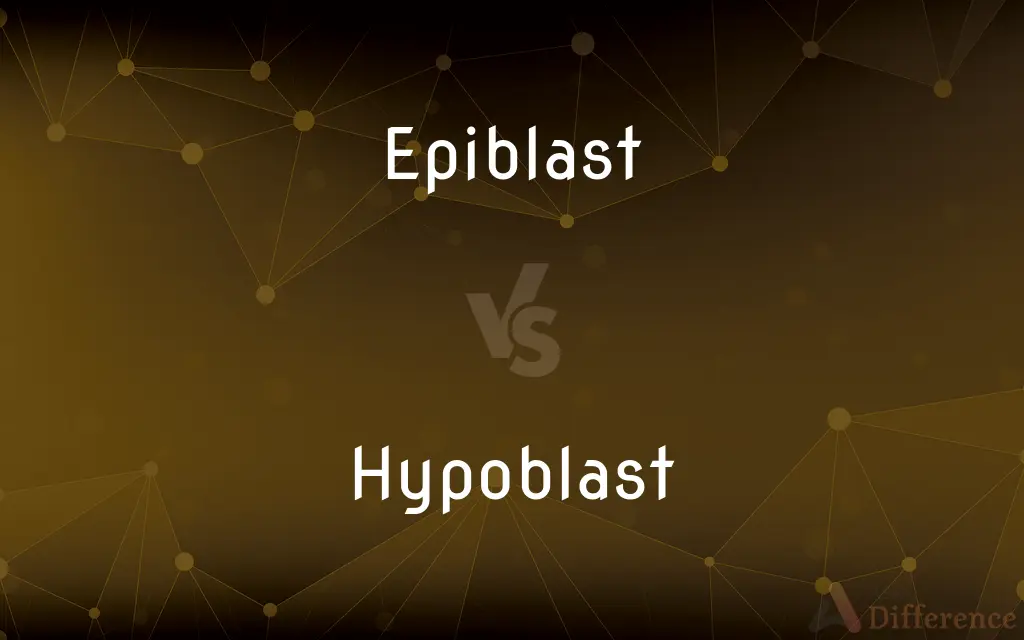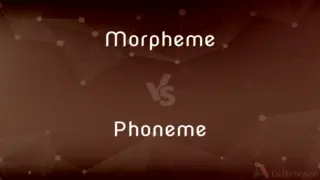Epiblast vs. Hypoblast — What's the Difference?
Edited by Tayyaba Rehman — By Fiza Rafique — Updated on October 11, 2023
Epiblast is the outermost layer of an embryo during early development, while Hypoblast is the innermost layer.

Difference Between Epiblast and Hypoblast
Table of Contents
ADVERTISEMENT
Key Differences
The Epiblast and Hypoblast are fundamental layers that are formed during the early stages of embryonic development. The Epiblast, situated dorsally, is the outermost layer, whereas the Hypoblast is positioned ventrally and serves as the innermost layer. Both play crucial roles in gastrulation and the formation of germ layers.
In the bilaminar embryonic disc, the Epiblast comprises tall columnar cells that subsequently give rise to ectoderm and mesoderm. On the other hand, the Hypoblast consists of small cuboidal cells, which later form the endoderm. Both these layers are vital in guiding the future development of the embryo.
It's important to note that the Epiblast cells also contribute to the formation of the amniotic cavity. The Hypoblast cells, in contrast, assist in creating the yolk sac. These structures play an instrumental role in nourishing and protecting the embryo as it grows.
Moreover, during gastrulation, cells from the Epiblast migrate to form the three primary germ layers: ectoderm, mesoderm, and endoderm. The Hypoblast, however, remains as the endodermal layer. The interactions between Epiblast and Hypoblast set the stage for the development of organs and tissues in the fetus.
Comparison Chart
Position
Outermost layer of the bilaminar embryonic disc
Innermost layer of the bilaminar disc
ADVERTISEMENT
Cell Type
Tall columnar cells
Small cuboidal cells
Future Contribution
Gives rise to ectoderm and mesoderm
Forms the endoderm
Associated Structures
Contributes to the amniotic cavity
Assists in creating the yolk sac
Role during Gastrulation
Participates in forming all three germ layers
Remains as the endodermal layer
Compare with Definitions
Epiblast
Epiblast is the outermost layer of an early embryo.
The Epiblast plays a pivotal role in early embryonic development.
Hypoblast
Hypoblast comprises small cuboidal cells.
Under the microscope, the Hypoblast's cuboidal cells were distinctly visible.
Epiblast
Epiblast consists of tall columnar cells.
Researchers observed the Epiblast's columnar cells under the microscope.
Hypoblast
Hypoblast is the innermost layer of an early embryo.
The inner layer, known as the Hypoblast, is crucial for endoderm formation.
Epiblast
Epiblast contributes to the formation of the amniotic cavity.
Without the Epiblast, the amniotic cavity wouldn't form properly.
Hypoblast
Hypoblast doesn't migrate during gastrulation like Epiblast cells.
While the Epiblast cells migrate, the Hypoblast cells stay in position.
Epiblast
Epiblast is responsible for giving rise to both ectoderm and mesoderm.
The origin of ectoderm and mesoderm can be traced back to the Epiblast.
Hypoblast
Hypoblast primarily forms the endoderm in the embryo.
The embryo's endoderm arises from the Hypoblast.
Epiblast
Epiblast cells participate in the process of gastrulation.
Scientists are studying how Epiblast cells migrate during gastrulation.
Hypoblast
Hypoblast helps in the formation of the yolk sac.
The yolk sac development is closely tied to the Hypoblast's function.
Epiblast
In amniote animal embryology, the epiblast (also known as the primitive ectoderm) is one of two distinct layers arising from the inner cell mass in the mammalian blastocyst or from the blastodisc in reptiles and birds. It derives the embryo proper through its differentiation into the three primary germ layers, ectoderm, mesoderm and endoderm, during gastrulation.
Hypoblast
In amniote embryology, the hypoblast, is one of two distinct layers arising from the inner cell mass in the mammalian blastocyst, or from the blastodisc in reptiles and birds. The hypoblast gives rise to the yolk sac, which in turn gives rise to the chorion.The hypoblast is a layer of cells in fish and amniotes embryos.
Epiblast
The outer layer of a blastula that gives rise to the ectoderm after gastrulation.
Hypoblast
See endoderm.
Epiblast
The outer layer of a blastula that, after gastrulation, becomes the ectoderm.
Hypoblast
(embryology) A type of tissue that forms from the inner cell mass and later is incorporated into the endoderm
Epiblast
The outer layer of the blastoderm; the ectoderm. See Blastoderm, Delamination.
Hypoblast
The inner or lower layer of the blastoderm; - called also endoderm, entoderm, and sometimes hypoderm. See Illust. of Blastoderm, Delamination, and Ectoderm.
Hypoblast
The inner germ layer that develops into the lining of the digestive and respiratory systems
Common Curiosities
Which layer plays a significant role in gastrulation?
The Epiblast plays a pivotal role in gastrulation by forming the three primary germ layers.
What is the Epiblast?
The Epiblast is the outermost layer of an early embryo.
Where is the Hypoblast located in relation to the Epiblast?
The Hypoblast is situated beneath the Epiblast, making it the innermost layer of the early embryo.
And the Hypoblast?
The Hypoblast consists of small cuboidal cells.
What about the Hypoblast?
The Hypoblast assists in creating the yolk sac.
Do both Epiblast and Hypoblast contribute to all three germ layers?
No, only the Epiblast gives rise to all three germ layers. The Hypoblast mainly forms the endoderm.
What types of cells comprise the Epiblast?
The Epiblast is made up of tall columnar cells.
Which structure is associated with the Epiblast's development?
The Epiblast contributes to the formation of the amniotic cavity.
Is the Hypoblast the same as the endoderm?
No, while the Hypoblast contributes to the formation of the endoderm, they are not synonymous.
Which layer is dorsal, Epiblast or Hypoblast?
The Epiblast is dorsal, and the Hypoblast is ventral.
How do the Epiblast and Hypoblast interact during development?
They work in tandem to create the bilaminar embryonic disc, a structure foundational to further development.
What happens to the Epiblast during embryonic folding?
The Epiblast forms the ectoderm and, through migration, contributes to the mesoderm.
How vital are these layers to embryonic development?
Both the Epiblast and Hypoblast are crucial as they guide the early stages of embryonic development, leading to the formation of tissues and organs.
What is the clinical significance of understanding these layers?
A comprehensive understanding of the Epiblast and Hypoblast is essential in embryology, as anomalies in their development can lead to congenital disorders.
Do both layers persist throughout development?
No, as development progresses, the Epiblast and Hypoblast undergo changes and differentiation to form various structures and germ layers.
Share Your Discovery

Previous Comparison
Morpheme vs. Phoneme
Next Comparison
Compliance vs. ViolationAuthor Spotlight
Written by
Fiza RafiqueFiza Rafique is a skilled content writer at AskDifference.com, where she meticulously refines and enhances written pieces. Drawing from her vast editorial expertise, Fiza ensures clarity, accuracy, and precision in every article. Passionate about language, she continually seeks to elevate the quality of content for readers worldwide.
Edited by
Tayyaba RehmanTayyaba Rehman is a distinguished writer, currently serving as a primary contributor to askdifference.com. As a researcher in semantics and etymology, Tayyaba's passion for the complexity of languages and their distinctions has found a perfect home on the platform. Tayyaba delves into the intricacies of language, distinguishing between commonly confused words and phrases, thereby providing clarity for readers worldwide.














































